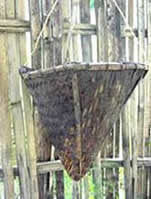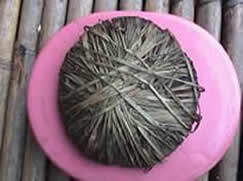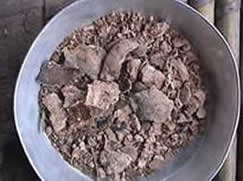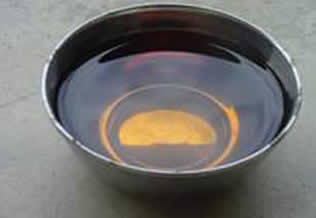India: Tapyo - A herbal salt of the Apatani
15/09/09
By Chandra Prakash Kala* and Mihin Dollo**
The Apatani group of villages located in Lower Subansiri district of Arunachal Pradesh in northeastern India, lie on the border of the Himalaya and Indo Burma Biodiversity Hotspots. Due to their geographical isolation - living in the interior of dense forests and unconnected by any means of communication - the villagers tried to evolve a self-sufficiency economy where they met their requirements from the surrounding natural resources.
 The Apatani are renowned for their meticulous agricultural practices and have also developed their own ingenious system of making salt to meet their nutritional requirements. It's hard to trace the history of this process as there are little written records but it probably dates back more than 100 years and possibly much further still. Called "Tapyo" by the communities, it's prepared using available herbaceous species around the villages: in the majority of cases from grasses such as Sarshe (Eleusine coracana) or Pepu (Phragmites karka, pictured left).
The Apatani are renowned for their meticulous agricultural practices and have also developed their own ingenious system of making salt to meet their nutritional requirements. It's hard to trace the history of this process as there are little written records but it probably dates back more than 100 years and possibly much further still. Called "Tapyo" by the communities, it's prepared using available herbaceous species around the villages: in the majority of cases from grasses such as Sarshe (Eleusine coracana) or Pepu (Phragmites karka, pictured left).
The community has multiple indigenous uses for Phragmites karka, such as the preparation of carpet (locally called as Dotananee Pepu), rope (Lobu Lomee), decoration and protection of houses (locally known as Thasee), fodder for cattle, and ethno-medicine for the treatment of coughs, fever and as an antipyretic. Over the years, the availability of Phragmites karka in the wild has declined due to frequent over-collection, mainly because it's the preferred species for the preparation of Tapyo. Phragmites karka is mainly restricted to river beds and river banks, which are prone to soil erosion, so it is ecologically important in binding the riverine soils, which subsequently helps to protect the forests in the Zero valley. In order to meet community requirements as well as retaining the ecological integrity of this Hotspot it is necessary to conserve this species by launching restoration programmes in its natural habitats.
Eleusine coracana or finger millet was once cultivated as a food crop across the middle Himalayan belt of India, but there are reports of its substantial decline in its entire cultivated range.
 To prepare Tapyo, about 3 quintals (300 kg) of base plant material is collected and sun dried for two to three hours (depending on the intensity of the sun). After drying it's immediately burnt to ashes away from the homestead in a "Piiro" to avoid contamination, smoke and air pollution. The ashes are then collected and kept in a conical shaped bamboo apparatus (locally called as Sader, pictured left) with a small outlet at the bottom.
To prepare Tapyo, about 3 quintals (300 kg) of base plant material is collected and sun dried for two to three hours (depending on the intensity of the sun). After drying it's immediately burnt to ashes away from the homestead in a "Piiro" to avoid contamination, smoke and air pollution. The ashes are then collected and kept in a conical shaped bamboo apparatus (locally called as Sader, pictured left) with a small outlet at the bottom.
Water is added gradually until the filtrate (Pilla) starts dripping from the bottom where it's collected in a cauldron. Another earthen pot is placed on the fire filled with starch-laden water of boiled rice (about 15 ml). After drying, a thin membranous layer forms in the cauldron, which reduces the chance of salt sticking to the sides.
Filtrate is then added to the pot and placed on the fire for 5 to 7 hours. About 15 litres of water is required to attain the desired thickness with the filtrate gradually being added until the solute attains a depth of approximately 3 cm. The pot is then removed from the fire and left to cool at room temperature.
Extracted plant filtrate collected for boiling
After cooling, a solid solute is put on the leaf from a plant locally known as Lolly (Molineria capitulata): leaves of this plant are not affected by chemical compounds in the solute. The leaf is rolled, wrapped and kept above a vessel of fermented rice beer, which is on the hearth (pictured below).

After three days the wet substance, which by now has absorbed the vapours of rice beer, is collected and kept above the fire place. The final substance, ready to consume, is around one kilo in weight and resembles a dried red clay.
Tapyo seemingly enhances the taste and increases the appetite for the rice beer and can also be used in place of mineral salt in food - the Apatani were using herbal salt long before mineral salts reached them. It's sold at roughly 300 Rupees ($6) per kg and is in great demand in the community where it's regarded as the most mouth-watering traditional preparation.
 But it's immunity to a debilitating disease that may be the most fascinating aspect of the Tapyo story. Goiter, an iodine deficiency disease in humans which limits thyroid gland activity, is generally seen in most of the tribal communities of the Arunachal Pradesh, but amazingly, goiters are not found among Apatani people.
But it's immunity to a debilitating disease that may be the most fascinating aspect of the Tapyo story. Goiter, an iodine deficiency disease in humans which limits thyroid gland activity, is generally seen in most of the tribal communities of the Arunachal Pradesh, but amazingly, goiters are not found among Apatani people.
Tapyo is one of the food habits which makes the Apatani distinct from the other tribal communities of the Arunachal Pradesh and it seems this traditional herbal salt, stemming from centuries of self-sufficient isolation, contains the iodine that may protect the Apatani people from this affliction.
